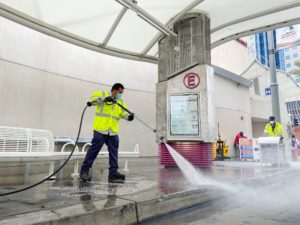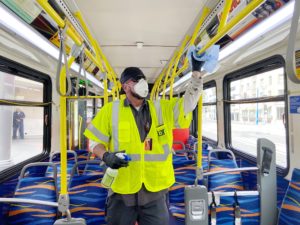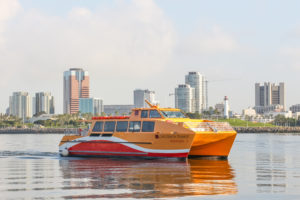During the pandemic, Long Beach Transit (LBT) kept its buses running throughout the city. Major routes in and out of Downtown were maintained on a schedule very close to pre-pandemic frequency, and buses citywide were (and continue to be) maintained with COVID-19 safety protocols in mind. As something resembling “normalcy” draws near, LBT promises a clean and safe ride, and encourages potential customers to reevaluate public transportation as a viable option in their lives.
on a schedule very close to pre-pandemic frequency, and buses citywide were (and continue to be) maintained with COVID-19 safety protocols in mind. As something resembling “normalcy” draws near, LBT promises a clean and safe ride, and encourages potential customers to reevaluate public transportation as a viable option in their lives.
When pandemic restrictions began during March of 2020, LBT introduced rear-door boarding, which encouraged social distancing and kept riders distant from the operator. Customers were asked to skip a seat or a row. Masks were (and still are) required on all LBT buses by federal mandate. Throughout the pandemic, fare collection was not enforced, and will not be until early July, when plexiglass barriers between the driver and riders are installed.
 Enhanced bus-cleaning protocols were introduced at the onset of the pandemic. “Our buses are typically cleaned every night,” said Michael Gold, Executive Director and Vice President of Customer Relations and Communication for LBT. “We continued to scrub all buses every night, but we added daytime cleaning during the pandemic; When the buses stopped for a 20-minute layover or a break at the Downtown Transit Gallery, crews went in and disinfected the high-touch areas. Handrails, exit signal ropes, doors, and seats were wiped down an additional time or two a day. Additionally, we limited capacity on each bus to around 10 people. These measures continue to be implemented.”
Enhanced bus-cleaning protocols were introduced at the onset of the pandemic. “Our buses are typically cleaned every night,” said Michael Gold, Executive Director and Vice President of Customer Relations and Communication for LBT. “We continued to scrub all buses every night, but we added daytime cleaning during the pandemic; When the buses stopped for a 20-minute layover or a break at the Downtown Transit Gallery, crews went in and disinfected the high-touch areas. Handrails, exit signal ropes, doors, and seats were wiped down an additional time or two a day. Additionally, we limited capacity on each bus to around 10 people. These measures continue to be implemented.”
As Long Beach begins to move on from the pandemic, LBT is moving forward cautiously. Increased service and bus capacity are expected in August, when students, who make up about 40% of LBT ridership, will be commuting once again.
LBT has partnered with the Moovit app to make bus trips easier; Moovit supplies real-time bus arrival information, along with door-to-door directions. “It’s a very easy way for people to plan their trip,” said Gold. 
Two of the most popular forms of transportation offered by LBT are the Aqualink and Aquabus. The Aqualink, LBT’s bright yellow, red, and white catamaran, which runs between Alamitos Bay and Downtown, returned over Memorial Day weekend. Thanks to a sponsorship from the Long Beach Convention and Visitors Bureau, rides on the Aqualink will be free through July 4th weekend. Capacity will be limited to 40 customers per trip, and the route will be limited to the Alamitos Bay and Aquarium of the Pacific docks; The Queen Mary stop is out for now. The Aquabus, which services the area around Rainbow Harbor, remains on pause but may return in July.
LA Metro operates the A Line (formerly the Blue Line) train service, which runs from Downtown Long Beach to Pasadena. Trains are available at the Downtown station every 20 minutes, 24 hours a day, and with somewhat less frequency during off hours. On the heels of a major A Line renovation in 2019 which included new sections of track, improvements to the power system and interactive digital navigation screens at every station, LA Metro introduced cleaning protocols similar to LBT’s at the start of the pandemic. This means that all public transportation options have your good health in mind as they move you to and from Downtown Long Beach.
“The pandemic has changed a lot of us, and prompted us to reevaluate our work and commuting habits,” said Gold. “LBT is a great option. Perhaps, now that you’re working from home, maybe you don’t need a car. I really encourage people to take a look at what LBT can offer them.”
